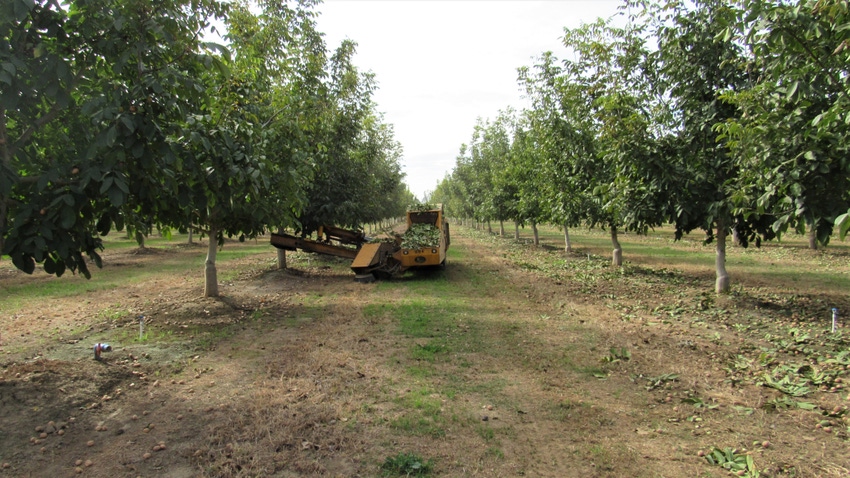
Winter has officially arrived, and along with it the expected rainy season across California’s tree nut country. Almond and walnut producers and other orchard operators are performing off-season tasks including sanitation, winter weed and pest management, including application of herbicides, and other tasks normally associated with the dormant season.
While orchard sanitation usually begins prior to the arrival of the rainy season, follow-up sanitation efforts can last through much of the winter months. Prior to wet ground conditions, most orchards use shaking equipment to dislodge mummy nuts from mature trees, though winter poling crews are often used in combination with shaking efforts, especially later in the winter season and before sanitation deadlines are reached.
In years when large numbers of mummy nuts cling throughout an orchard, some growers prefer to perform late-winter shaking, if dry soil conditions permit, to ensure sanitation is complete, preferably two weeks before bloom. For southern Valley orchards, the end of January is a fair target date to complete sanitation efforts, while northern orchards could extend that timetable by a week or two depending on seasonal conditions.
SECONDARY SHAKING
In high mummy-count orchards, especially for large orchard operations, secondary shaking has become more common, primarily because sanitation is a time-intensive process and one that is necessary to prevent an outbreak of navel orangeworm and diseases in the spring.
“A lot of growers prefer to wait to perform much of their sanitation efforts until the fog and rains arrive, when moisture levels are higher to help loosen mummy nuts in the trees and make them easier to remove,” says Mohammad Yaghmour, UC-ANR area orchard systems advisor for Kern County. “The moisture makes those nuts a little bit heavier, so when growers get their equipment inside the orchard and shake their trees, it allows mummy nuts to dislodge.” He says many Kern County growers are opting to perform much of their sanitation efforts later in the winter season with good success.
David Doll, formerly a long time UC-ANR pomology farm advisor and creator and editor of the Almond Doctor newsletter, says along with concerns for navel orangeworm, many growers have expressed some concern that tree shaking late in the winter season might impact nut yields in the coming season. He says the last-known study of tree shaking effects on almond nut yields was published in 1983, and suggests more study may be needed to update those findings.
G. Steven Sibbett, University of California Cooperative Extension farm advisor emeritus, was one of the four authors of that original study and says that he still stands by the principle that tree shaking in an almond orchard in late winter can reduce navel orangeworm damage by as much as 80 percent overall. But, he says, common sense is required to prevent over-shaking trees.
SHAKING RELATIVELY SAFE
“Mummy nuts can be removed by mechanical tree shaking in the dormant season, certainly in December and (as late as] January,” Sibbett says. “Since some flower buds are also removed by shaking, growers are reluctant to use this method of orchard sanitation, fearing that the following crop will be affected.”
But, he says, the study indicates using mechanical shakers is relatively safe in the orchard up until about two to three weeks before first bloom, or specifically until the beginning of bud swell, and contrary to expressed concerns, there is no evidence to support that late-season mechanical shaking will decrease yields when performed with care.
“After extensive trials during our research, the conclusion of our original studies was that yields are not at risk from late-season mechanical sanitation,” Sibbett says. “This holds as true today as they did 35 years ago. We selected uniform trees of the Nonpareil and Merced cultivars planted in Famoso, Kern County, Calif., and we selected four shaking dates to perform our research —Dec. 11, and Jan. 6, 16, and 31.”
A conventional trunk shaker was used exclusively and duration was based on previous experience to gain adequate mummy removal: Nonpareil trees were shaken 10 seconds to 12 seconds; Merced trees, 4 seconds to 5 seconds.
At harvest, the target tree yields were compared to yields produced by trees that were not subjected to late-season shaking. The result indicated the number of nuts and weight of nut meats per tree were the same for test trees as they were for non-test trees. “In other words, yields and weights were not affected by mechanical shaking in our trials,” Sibbett says.
COMPREHENSIVE SANITATION REQUIRED
Regardless the method, orchard advisors say comprehensive sanitation is required in the control of navel orangeworm, and they remind growers that sanitation efforts need to be concluded before bloom (Feb. 1), regardless of the method they choose. Most agree that a combination of mechanical shaking and poling will be required to clean the orchard properly before the new bloom arrives.
Sanitation remains the first priority in controlling NOW outbreaks. Regardless the amount of sprays or control efforts later in the season, effective NOW control must start with good sanitation practices.
Good sanitation offers two primary benefits: the direct reduction of overwintering populations by increased larval mortality, and the reduction of egg-laying and development sites of the early spring generations. NOW control starts with effective sanitation.
Finally, remember that mummies must be destroyed by flail mowing or disking by March 1.
About the Author(s)
You May Also Like






